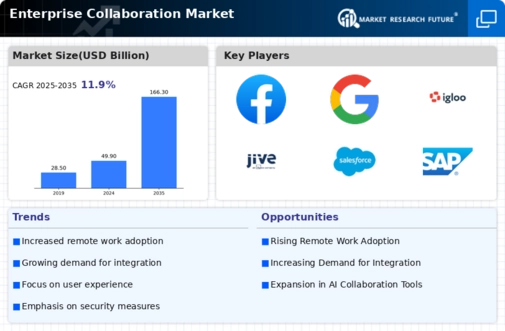The Enterprise Collaboration Market is currently characterized by a dynamic competitive landscape, driven by the increasing demand for seamless communication and collaboration tools across organizations. Key players such as Microsoft (US), Slack Technologies (US), and Google (US) are strategically positioned to leverage their technological prowess and extensive user bases. Microsoft (US) continues to enhance its Teams platform, focusing on integration with other Microsoft 365 services, thereby fostering a cohesive ecosystem that appeals to enterprises seeking comprehensive solutions. Meanwhile, Slack Technologies (US) emphasizes its open platform approach, facilitating integrations with various third-party applications, which enhances its appeal to diverse business environments. Google (US) is also making strides with its Google Workspace, focusing on AI-driven features that streamline collaboration, indicating a trend towards intelligent solutions that enhance productivity.
The business tactics employed by these companies reflect a concerted effort to optimize their offerings. For instance, localizing services to cater to regional markets and optimizing supply chains are prevalent strategies. The market appears moderately fragmented, with a mix of established players and emerging startups, each contributing to a competitive structure that fosters innovation and responsiveness to customer needs. The collective influence of these key players shapes the market, as they continuously adapt to evolving technological landscapes and user expectations.
In November 2025, Microsoft (US) announced a significant upgrade to its Teams platform, introducing advanced AI capabilities that enhance real-time collaboration and automate routine tasks. This strategic move not only reinforces Microsoft’s commitment to innovation but also positions Teams as a leader in the enterprise collaboration space, potentially attracting new users seeking cutting-edge solutions. The integration of AI into collaboration tools is likely to redefine user experiences, making workflows more efficient and intuitive.
In October 2025, Slack Technologies (US) launched a new feature that allows users to create customized workflows using no-code tools. This initiative aims to empower users to tailor their collaboration experiences without requiring extensive technical knowledge. By democratizing workflow automation, Slack enhances its value proposition, appealing to a broader audience and fostering greater user engagement. This strategic focus on user empowerment may lead to increased customer loyalty and retention in a competitive market.
In September 2025, Google (US) unveiled a partnership with several educational institutions to integrate Google Workspace into their curricula. This collaboration not only expands Google’s reach into the education sector but also positions its tools as essential for future generations of professionals. By embedding its collaboration tools in educational settings, Google is likely to cultivate a loyal user base that will carry these tools into their professional lives, thereby ensuring long-term market presence.
As of December 2025, the competitive trends in the Enterprise Collaboration Market are increasingly defined by digitalization, sustainability, and AI integration. Strategic alliances among key players are shaping the landscape, fostering innovation and enhancing service offerings. The shift from price-based competition to a focus on technological advancement and supply chain reliability is evident, suggesting that future differentiation will hinge on the ability to innovate and adapt to changing market demands. Companies that prioritize these aspects are likely to thrive in an evolving environment.

















Leave a Comment